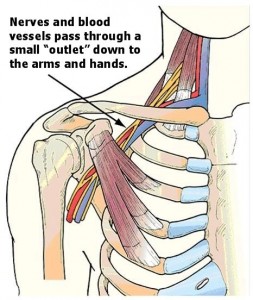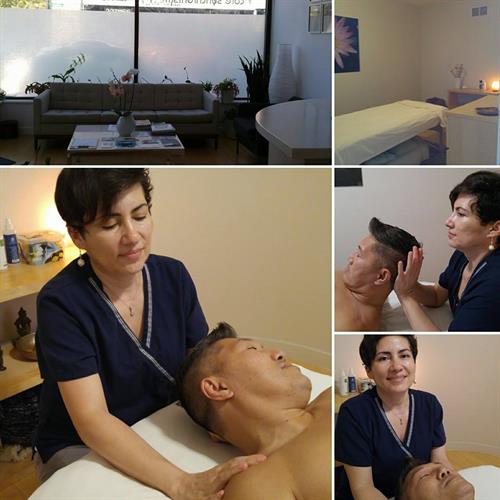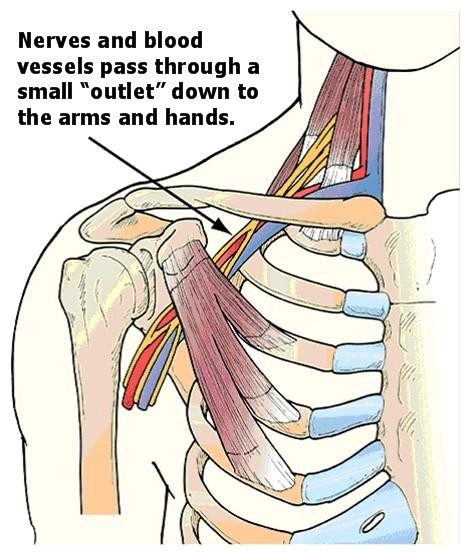Posture. Posture. Posture!!! The realization of the importance of a proper posture is paramount to the treatment of thoracic outlet syndrome.
Alternative treatment of thoracic outlet syndrome – Neuromuscular Therapy addresses the elements that cause muscular pain and dysfunctional movement. Release adhesions causing nerve entrapment; reduce muscle spasm or contractures causing nerve entrapment.
Treat the muscles of the shoulder, neck and upper back; scalenes, trapezius, SCM, pectoralis major and minor, subclavius, rhomboids.
Find the source of compensation, the why your shoulder muscles are imbalanced and contributing to the kinetic chain of dysfunction.
For example: The pectoralis minor is a muscle that becomes easily shortened and tight due to many factors, including rounded shoulder posture, glenohumeral joint dysfunction, breathing dysfunction, and a variety of compensation patterns. It sits on top of the brachial plexus, and can therefore contribute to Thoracic Outlet Syndrome.
Ischemia—lack of blood flow to soft tissue. Trigger Points—irritated points in the muscles that refer pain Postural Distortion—imbalance of muscular system. Correct postural deviations. Look at the whole body and see how the shoulders and neck are influenced by the lower body. Biomechanical Dysfunction—Imbalance resulting from faulty movement. Re-educate and increase awareness of posture.
Lastly, treating locally and not considering the body as a whole can be extremely shortsighted. Treatment is focused on following the kinetic chain of dysfunctional patterns and locating the source for long lasting results.
What is it? (TOS) is a neurovascular entrapment, the nerves of the brachial plexus or the blood vessels running to or from the arm (or some combination of both) are impinged or impaired at the thoracic outlet:
Signs and Symptoms:
Thoracic outlet syndrome symptoms can vary, depending on which structures are compressed. When nerves are compressed, signs and symptoms of neurological thoracic outlet syndrome include:
- Wasting in the fleshy base of your thumb (Gilliatt-Sumner hand)
- Numbness or tingling in your arm or fingers
- Pain or aches in your neck, shoulder or hand
- Weakening grip
Signs and symptoms of vascular thoracic outlet syndrome can include:
- Discoloration of your hand (bluish color)
- Arm pain and swelling, possibly due to blood clots
- Blood clot in veins or arteries in the upper area of your body
- Lack of color (pallor) in one or more of your fingers or your entire hand
- Weak or no pulse in the affected arm
- Cold fingers, hands or arms
- Arm fatigue after activity
- Numbness or tingling in your fingers
- Weakness of arm or neck
- Throbbing lump near your collarbone
Symptoms tend to be worse at night, when you lift the affected arm over your head, or when your tired from other activities.
TOS should be treated due to pectoralis major and subclavius downward pull on the clavicle. This tension, coupled with upward pull of the 1st and 2nd ribs by the scalene muscles, can close the space leading to impingement of the neurovascular and/or lymphatic structures serving the upper extremity.
A bundle of nerves: Because the brachial plexus passes through an opening between the anterior and middle scalene muscles, over activity, whether caused by facilitation or inhibition, must be addressed. The extra pressure on the brachial plexus caused by hypertonic scalene muscles can result in Thoracic Outlet Syndrome.
What are the triggers
Although postural habits and bony growth patterns can make a person susceptible to TOS, it often seems to be precipitated by specific traumatic event: a hyperextension injury (whiplash) or a repetitive stress situation similar to the factors seen with carpal tunnel syndrome.
Other possible culprits: Cervical misalignment, Rib misalignment, Cervical ribs, Tight muscles, Spondylosis, Atrophied. How can we help?
[schedule_now]

